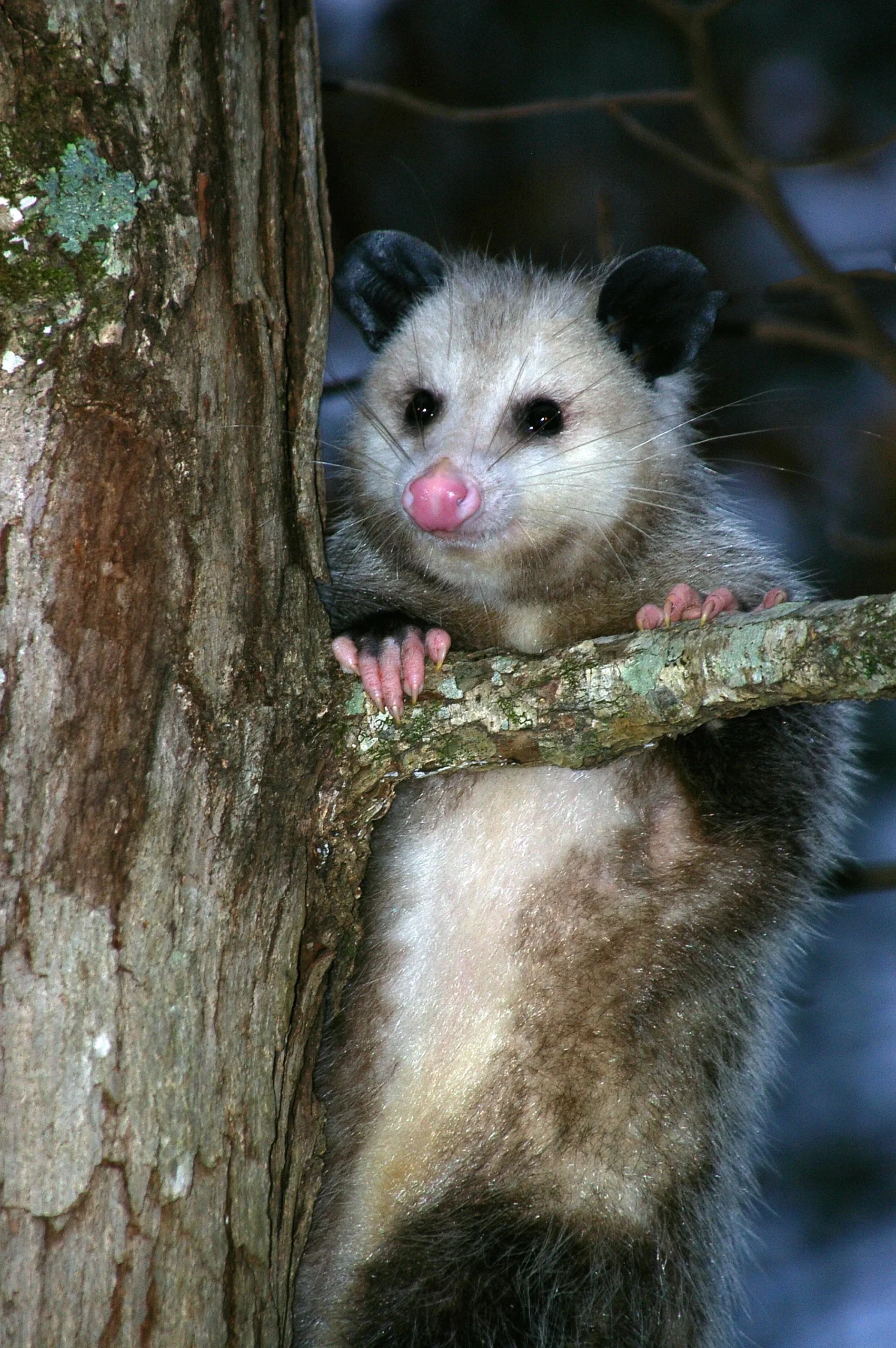

If you could travel back thousands of years, you’d find yourself surrounded by bizarre and unfamiliar creatures: Alticamelus, the “high camel” of America with the neck and legs of a giraffe; Castoroides, a 9-foot-tall beaver; Latifrons the bison, whose horns stretched eight feet from tip to tip; and Megatherium, Mylodon and Megalonyx, mighty ground sloths the size of elephants. Amid these strange beings, one animal would stand out as familiar. Didelphis, the opossum, remains a living fossil, practically unchanged since it first appeared on Earth eons ago.
The possum, as we usually call it, ranks as North America’s most primitive mammal. It’s a marsupial, the only one on our continent, with the female raising her undeveloped young in a pouch. Australia’s kangaroo serves as another well-known marsupial.
Naturalist Eva Rodimer aptly described the opossum as “a strange creature with neither beauty nor brains—a scramble of rat and cat and grizzled fur.” Its appearance is rather untidy, with coarse grayish fur that looks as if it needs a haircut. The black ears are hairless, and the scaly prehensile tail is long and naked, like that of a rat.
A pink nose tips the possum’s long, pointed snout, and in its mouth are 50 teeth, more than any other North American mammal. Each foot has five toes, but the first toe on each rear foot lacks a nail and functions like a thumb.
Possums have thrived for so long because they adapt to nearly any situation. They’ll eat almost anything—fruit, carrion, insects, rabbits, birds, eggs, rats, garden crops, even the contents of a garbage can.
Finding a place to live poses no problem, either. Possums are equally comfortable in an empty squirrel’s nest, a hollow tree, a brush pile or a cozy hole under your front porch. They thrive from sea level to mountaintops in many habitats but particularly favor bottomland forests along streams. I regularly see them in our suburban yard, snuffling around our bird feeders and garbage cans as they look for something to eat.
The most misunderstood part of the possum’s life story involves how they conceive and give birth. Many people mistakenly believe possums breed through their nose. While males have a forked penis and females have paired vaginal canals, breeding occurs like in other mammals, usually early in the year.
After a brief gestation of only 13 days, the tiny, undeveloped babies are born. At this stage, 16-20 could fit in the bowl of a tablespoon. Up to 25 may be born, but the mother has only 13 nipples. Only the babies lucky enough to find a nipple will survive.
As the young are born, the female sits with her neck arched and her head close to the pouch, which has led to another myth about possums blowing their young into the pouch. In reality, as the young emerge, they must struggle up their mother’s belly to reach the pouch and attach to a teat. They remain attached for months, growing tenfold in size during the first week. By 70-80 days old, they’re rat-sized and start leaving the pouch for short periods.
Outside their mother’s pouch, the young cling tightly to her shaggy coat. It’s commonly thought that the female arches her tail over her back and the young hook their tails over hers to hold on. However, this too is just a myth.
Possums face many enemies, the worst of which is humans. Trappers capture millions each year for their fur, while hunters seek them out for a Southern dish of “possum and sweet potatoes.” Untold thousands die as victims of highway traffic.
Birds of prey, coyotes, foxes, dogs, bobcats and other animals also take their toll. Though equipped with many sharp teeth and given to displays of bravado punctuated by loud hissing, the opossum generally won’t fight. If hissing doesn’t intimidate the enemy, the animal rolls over and pretends to be dead, “playing possum.” Whether this act is conscious or simply fainting remains uncertain, but once the danger passes, the animal soon scurries off with its peculiar rolling gait.
We may think of the possum with little regard, as an insignificant creature. Yet, this small, unassuming animal has ambled safely through eons littered with the bones of the swift and the strong. If nothing else, Br’er Possum is a survivor, one of the Arkansas’ most unique and intriguing mammals.
______________________________________________________________________
Fun Facts About Opossums

Keith “Catfish” Sutton of Alexander, Arkansas, is one of the country’s best-known outdoor
journalists. His stories and photographs about fishing, hunting, wildlife and conservation have
been read by millions in hundreds of books, magazines, newspapers and websites. He and his
wife Theresa own C&C Outdoor Productions Inc., an Arkansas-based writing, photography,
lecturing and editorial service.




Get DownHome Arkansas blog posts, news, and more directly by email. Give us your name and email if you’d like to subscribe.